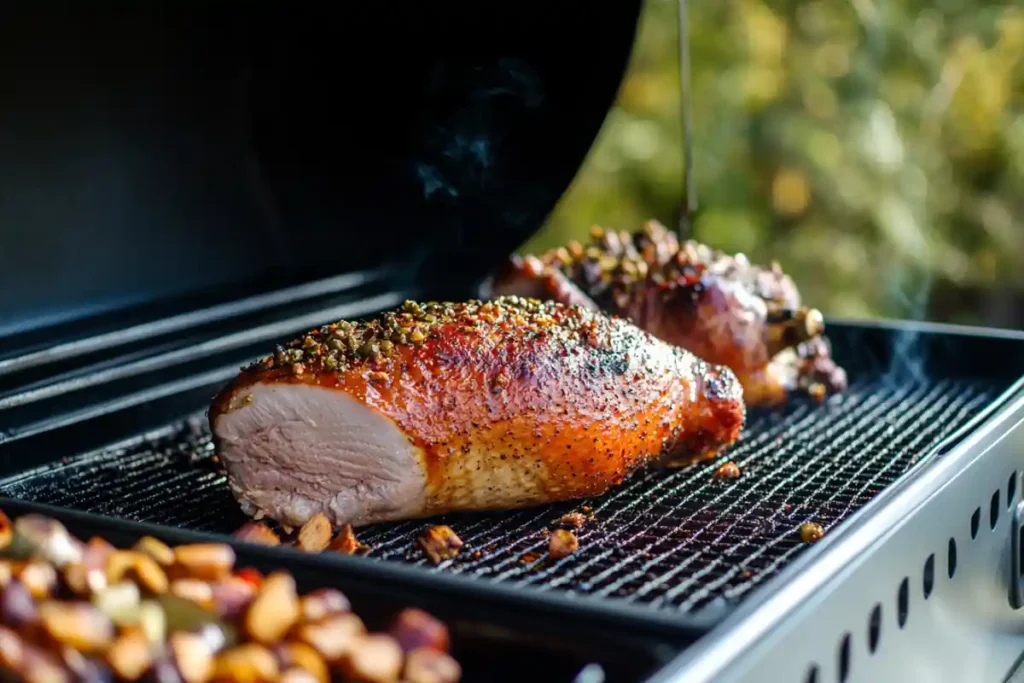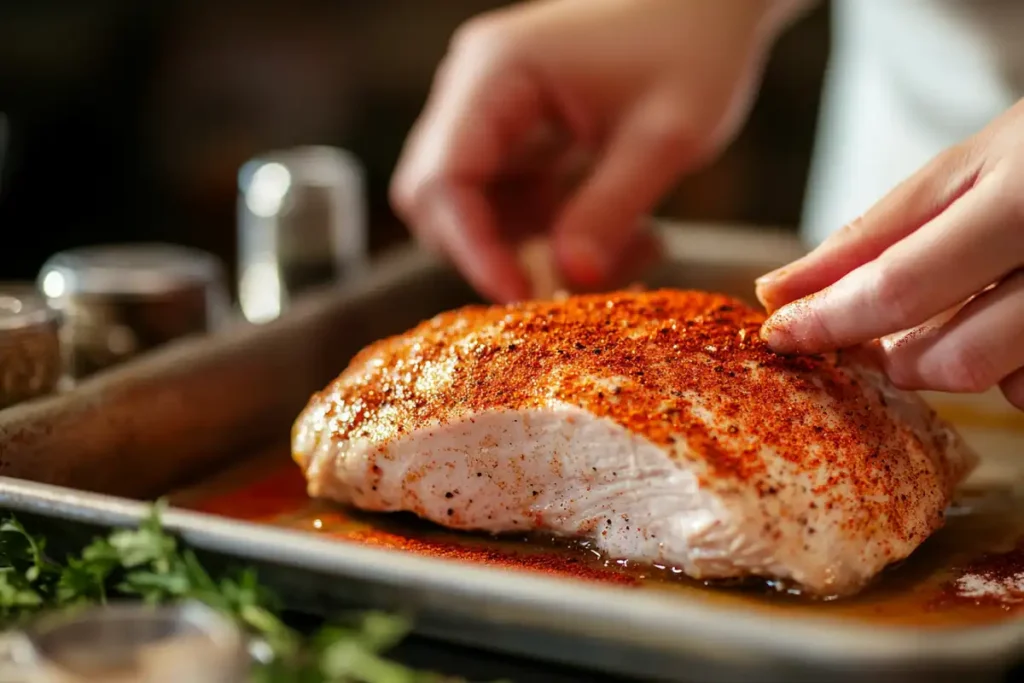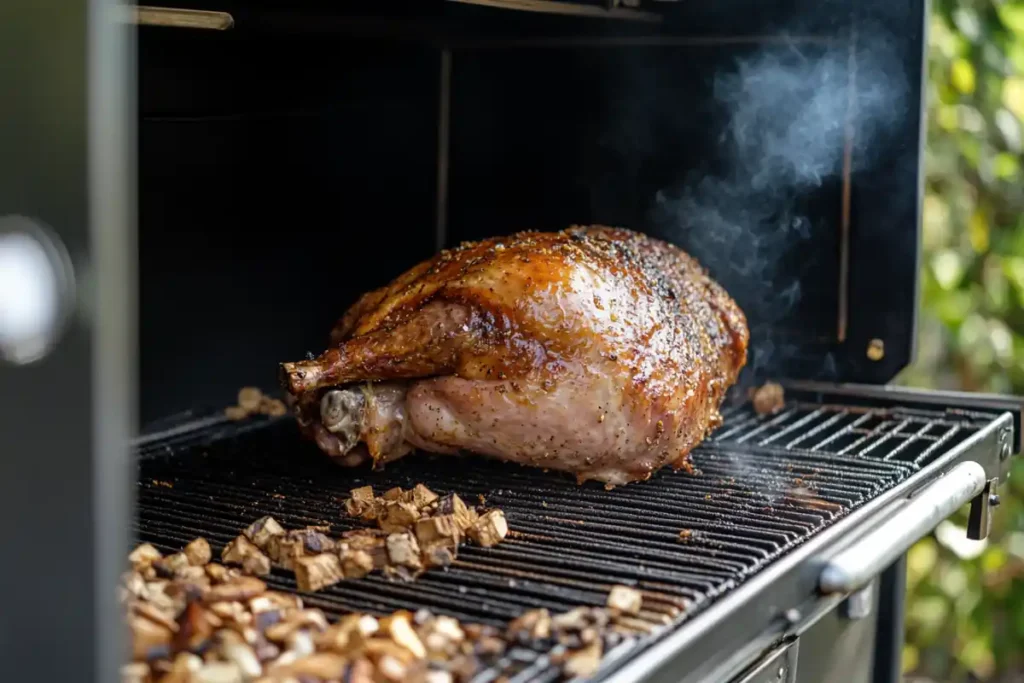Smoking a turkey breast can seem daunting if you’re new to the world of barbecue. However, with proper preparation, the right temperature, and quality wood, you can achieve a tender and flavorful result. In this guide, you’ll learn how long does it take to smoke a turkey breast?, along with essential tips, techniques, and best practices that ensure perfect results every time.
Before diving deeper, it’s important to handle poultry safely. For detailed proper turkey cooking temperatures, consider reviewing the USDA’s official guidelines. In addition, always keep food safety top of mind. For further food safety recommendations, check the CDC’s resource page, where you’ll find comprehensive information on proper handling, cooking, and storage.
For professional insights, especially if you’re refining your smoking technique, look to trusted sources. Weber’s grilling guide, for example, offers excellent pointers on controlling heat and smoke. Consider applying their methods to your own approach, and you’ll soon feel more confident about the process.
Why Focus on Smoking a Turkey Breast?

Smoke a Turkey Breast with ease and confidence by following a few straightforward steps. When you Smoke a Turkey Breast, it’s often simpler than tackling an entire bird. The leaner, smaller size means you’ll spend less time cooking and more time enjoying the results. By choosing to Smoke a Turkey Breast, you avoid the complexity of juggling various parts of the bird with different cooking times, allowing you to focus on a uniform cut of meat. This uniformity makes it easier to ensure a perfectly timed, tender, and juicy centerpiece.
Moreover, a smoked turkey breast pairs beautifully with a variety of sides. For example, to create a balanced meal with vibrant flavors, serve it with DaintyRecipe.com’s Delicious Maple-Glazed Brussels Sprouts. Their subtle sweetness contrasts perfectly with the smoky turkey.
Choosing the Right Turkey Breast

When selecting your turkey breast, size matters. A medium-sized breast, around 4 to 8 pounds, cooks more evenly. Fresh is best if possible, but frozen works well if thawed correctly. Check labels for pre-brined or enhanced turkey breasts. Pre-brined products may contain added salt, so adjust your seasonings accordingly.
Key considerations:
- Size: Aim for 4-8 lbs. for even cooking.
- Quality: Fresh or minimally processed.
- Pre-brined?: Factor this into your seasoning.
Essential Tools for Success
To master how long does it take to smoke a turkey breast?, invest in the right tools. Quality equipment ensures consistent heat, steady smoke, and safe handling.
Must-have items:
- Smoker: Charcoal, pellet, electric, or offset smokers work well.
- Thermometer: A reliable instant-read thermometer or probe is essential.
- Wood Chunks or Pellets: Opt for mild woods like apple, cherry, or pecan.
- Drip Pan: Catches drippings, helps maintain moisture.
- Sharp Knife & Tongs: For trimming, carving, and handling hot grates.
Preparing the Turkey Breast
Thawing Safely
If starting with a frozen turkey breast, thaw it in the refrigerator. Allow roughly 24 hours for every 4 pounds. This slow thawing method ensures even defrosting and reduces the risk of bacterial growth. Never thaw at room temperature, as it invites unsafe conditions.
Brining and Seasoning
Brining adds moisture and flavor. A simple brine of water, salt, and sugar for 12 to 24 hours boosts tenderness. After brining, pat the turkey breast dry and apply a basic rub of salt, pepper, paprika, and garlic powder. Adjust the spices to your liking. Keep seasonings simple at first, then experiment with subtle herbs or citrus zest over time.
Bringing to Room Temperature
Remove the turkey breast from the fridge about 30-60 minutes before cooking. Allowing it to rest at room temperature helps it cook evenly. This prevents the outside from overcooking while waiting for the inside to reach a safe temperature.
Step-by-Step Smoking Process

Step 1: Preheat the Smoker
Preheat your smoker to around 225°F. This lower-and-slow temperature ensures juicy, tender meat. At this setting, estimate about 30 to 40 minutes per pound, although exact times vary. Remember, use time as a guideline and temperature as your true indicator.
Step 2: Add Wood for Smoke
When your smoker reaches the target temperature, add chosen wood chunks or pellets. Mild woods like apple, cherry, or pecan impart a gentle smoke that complements poultry. Avoid overpowering the turkey with strong woods like hickory unless you blend them with milder options.
Step 3: Position the Turkey Breast
Place the turkey breast on the smoker’s grate, skin-side up, allowing ample airflow around the meat. Consider placing a drip pan underneath to catch flavorful drippings. Later, these drippings can enhance your gravy or sauce, adding depth and richness to your meal.
Step 4: Monitor the Internal Temperature
Insert a digital thermometer into the thickest part of the breast, avoiding bone. Resist opening the lid often. Every time you peek, the temperature drops, extending cooking time. Aim for an internal temperature of 165°F. However, consider pulling the turkey off at around 160°F, then tenting it with foil. Carryover heat will gently raise it to a safe 165°F.
Step 5: Adjusting Smoke and Heat
Control vents and dampers to keep the smoker’s temperature steady. If it dips too low, add fuel. If it climbs, reduce airflow. Strive for steady, thin smoke. Thick, billowing smoke can lead to bitter flavors. Remember, subtlety matters.
Step 6: Rest and Carve
After reaching the desired internal temperature, remove the turkey breast and let it rest for 15-20 minutes. Resting redistributes the juices, ensuring every slice is moist and flavorful. Carve against the grain for the best texture. Serve immediately or store leftovers properly.
Estimating Time: How Long Does It Take to Smoke a Turkey Breast?
The exact time varies. Generally:
- At 225°F: About 30-40 minutes per pound.
- At 250°F: Slightly quicker, around 25-35 minutes per pound.
For instance, a 6-pound turkey breast at 225°F may take 3 to 4 hours. Yet, always rely on internal temperature rather than just the clock. Variables like smoker type, weather, and breast size influence the total cooking time. Use timing as a rough guide, but the thermometer is your best friend.
Maintaining Moisture
To keep your turkey breast juicy, brining is the first step. Additionally, consider using a water pan in the smoker to maintain a humid environment. Some pitmasters lightly spritz the turkey with apple juice or broth during cooking. However, avoid constant lid openings. Each peek lowers internal heat and extends the overall cooking process.
A thin coating of melted butter on the skin before smoking also helps maintain moisture and adds a rich, golden hue. Experiment with these methods until you find a balance that delivers tender, succulent results every time.
Wood Choices and Flavor Profiles
Your choice of wood affects taste and aroma. Turkey’s delicate flavor pairs well with mild, fruity woods.
Recommended Woods:
- Apple: Sweet, mild, and versatile.
- Cherry: Delicate sweetness, adds appealing color.
- Pecan: Nutty and subtle, complements poultry beautifully.
- Maple: Gentle sweetness and warmth.
Hickory or mesquite are stronger and can overpower turkey if used alone. Blend them with a milder wood to achieve a balanced flavor that doesn’t dominate the natural taste of the turkey breast.
Seasoning Suggestions and Variations
Start simple. Salt, pepper, paprika, and garlic powder provide a classic foundation. Add onion powder or dried herbs like thyme or rosemary for a refined touch. For a hint of sweetness, sprinkle a bit of brown sugar. If you crave more complexity, experiment with mild chilies for gentle warmth or citrus zest for brightness.
Balance is key. You want to enhance the turkey’s natural flavor, not mask it. Keep a cooking journal to remember what worked best so you can refine your approach over time.
Serving Suggestions
Your smoked turkey breast deserves equally delicious sides. Pair it with mashed potatoes, roasted vegetables, or a zesty cranberry relish. For a savory-sweet contrast, try serving it alongside DaintyRecipe.com’s Perfect Turkey Gravy, which will elevate the entire meal with silky richness.
Light wines, crisp whites, or mild IPAs can complement the smoky notes without overshadowing them. Keep your beverage choices simple and refreshing.
Avoiding Common Pitfalls
Don’t rush: Smoking is slow cooking. Patience ensures tender results.
Don’t skip the thermometer: Internal temperature trumps time. Always verify doneness with a reliable thermometer.
Don’t oversmoke: Too much smoke results in a bitter flavor. Aim for thin, blue wisps of smoke.
Don’t forget to rest: Allowing the turkey to rest after cooking preserves its juicy texture.
Don’t ignore safety: Always follow food safety guidelines, wash hands and surfaces, and keep raw poultry separate.
Adjusting Cooking Times and Methods
If you’re short on time, raising the smoker temperature to 250°F speeds things up. However, slightly higher heat risks losing a bit of moisture. Consider starting at 225°F for maximum juiciness, then bumping up to 250°F if you’re running behind schedule.
Another option: split a large turkey breast into two smaller portions. Smaller pieces cook faster and may absorb smoke more efficiently. This strategy is especially handy when serving a crowd without extending your cook time significantly.
Storing and Reheating Leftovers
Refrigerate leftovers in airtight containers and consume them within 3 to 4 days. To reheat without drying, add a splash of broth and warm gently in the oven. For detailed instructions, DaintyRecipe.com’s How to Reheat Smoked Turkey offers excellent tips.
Use leftover smoked turkey in sandwiches, salads, or soups. Its distinctive smoky flavor adds depth to various dishes. Consider mixing it into a pasta dish or grain bowl for a quick, satisfying meal.
Developing Your Personal Technique
As you gain experience, tweak your approach. Experiment with different wood combinations, seasoning blends, and temperature settings. Over time, you’ll discover a method tailored to your taste and equipment. Document your results to track what you like best.
Smoking turkey breast is an art, so enjoy the journey. Embrace small adjustments and gradual improvements. Soon, smoking turkey will feel second nature, and you’ll look forward to the mouthwatering aromas that greet you each time you fire up the smoker.
Seasonal and Festive Touches
Reflect the season by adding herbs like sage and rosemary during the holidays. For a summer barbecue vibe, incorporate lemon zest and serve with grilled vegetables. A sweet maple glaze in autumn or a bright citrus glaze in spring brings a refreshing twist.
Pair your smoked turkey with seasonal sides that celebrate the time of year. Fresh, in-season produce and appropriate herbs highlight the turkey’s delicate smoky notes and enhance the overall dining experience.
Troubleshooting Common Issues
Uneven cooking: Rotate the turkey breast mid-cook. Different smoker spots may heat unevenly.
Excessive smoke flavor: Use less wood or milder varieties. Reduce smoking time.
Dry meat: Extend brining time, spritz more often, or lower the heat slightly.
Overly dark skin: Tent the turkey with foil once it reaches your desired color but needs more time to hit the target temperature.
By identifying and fixing issues as they arise, you’ll steadily improve your smoking technique.
Frequently Asked Questions
How long does it take to smoke a turkey breast at 225?
At 225°F, plan on about 30 to 40 minutes per pound. For a 6-pound turkey breast, expect roughly 3 to 4 hours. Always rely on a thermometer to ensure it reaches at least 165°F internally.
How do you keep a turkey breast from drying out when smoking?
Brine the turkey breast before cooking to boost moisture retention. Maintain a steady smoking temperature and avoid lifting the lid too often. Using a water pan and occasionally spritzing the meat can help, as does a brief rest period before carving.
Is it better to smoke a turkey at 225 or 250?
Both temperatures work. Smoking at 225°F takes longer but often results in juicier meat. At 250°F, you’ll finish faster, but monitor closely to prevent dryness. Choose a temperature that fits your schedule and flavor preference.
Can you smoke a turkey in 2 hours?
Two hours is typically too short for a full turkey breast unless it’s very small. Even a small breast usually needs at least 2.5 to 3 hours at 225°F or 250°F. Always verify doneness with a thermometer rather than relying on time alone.

